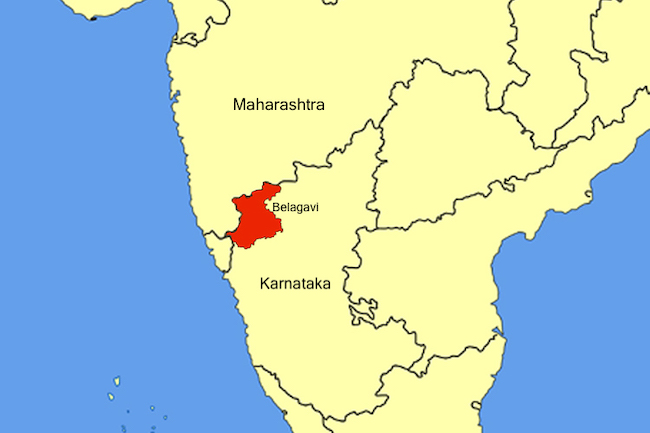Karnataka-Maharashtra Border Dispute
2022 DEC 15
Mains >
Constitution > Union and States > State reorganisation
IN NEWS:
- The long-standing border dispute between Karnataka and Maharashtra flared up shortly before the case was due to come up in the Supreme Court.
- Maharashtra is seeking the integration of 865 predominantly Marathi-speaking villages in the border districts of Belgaum, Karwar, Bidar and Gulbarga, and the six towns of Belgaum, Nipani, Khanapur, Karwar, Halyal and Bhalki.
- Karnataka has argued for the inclusion of areas in Sholapur and Sangli (Jath taluk), Kolhapur districts (falling under Maharashtra) in its territory
HISTORICAL BACKGROUND:
- 1947: 814 villages and the three urban settlements of Belgaum, Karwar and Nipani were part of the Bombay Presidency before Independence.
- 1956-1960: States Reorganization Act gave Belgaum, Karwar, Nipani and other areas (having sizable population of Marathi speakers) to Mysore (Later Karnataka). Maharashtra objected to this by claiming that in 1956, Marathi-speakers outnumbered Kannada-speakers in those areas.
- 1966: At Maharashtra’s insistence, the Union government constituted the Mahajan Commission to look into the dispute
- 1967: While rejecting Maharashtra’s claim over Belagavi (then Belgaum), the commission recommended 247 villages/places should remain as part of Karnataka. It also declared 264 villages /places including Nipani, Khanapur and Nandagad, to be made part of Maharashtra. The report was rejected by Maharashtra, while Karnataka welcomed it.
- 2004: In 2004, the Maharashtra government filed a petition under Article 131(b) in the Supreme Court, staking claim over Marathi-speaking villages in Karnataka. Meanwhile, Karnataka changed the name of Belgaum to Belagavi and made it the second capital of the state.

MAHARASHTRA’S ARGUMENTS:
- To seek the readjustment of its border on the basis of contiguity, relative linguistic majority and wishes of the people.
- While the claim over Belagavi and surrounding areas was based on Marathi-speaking people and linguistic homogeneity, its claim over Karwar and Supa (Konkani speaking areas) was by citing Konkani as a dialect of Marathi.
- Maharashtra also points out the historical fact that the revenue records in these Marathi-speaking areas are also kept in Marathi.
KARNATAKA’S ARGUMENTS:
- Karnataka points out that when INC redrew its circles on linguistic basis in 1920,it included Belagavi in the Karnataka Provincial Congress Committee.
- Karnataka also holds the view that the settlement of boundaries as per the States Reorganisation Act is final.
- The State argues that the issue would reopen border issues that have not been contemplated under the Act, and that such a demand should not be permitted.
- Maharashtra-Karnataka border row has been pending before the Supreme Court since 2004.
UNION GOVERNMENT’S STANCE
- Despite demands from Karnataka, the Centre never implemented the recommendations of the Mahajan Commission report.
- In 2010, the Centre in its affidavit had stated that the transfer of certain areas to then Mysore (now Karnataka) was neither arbitrary nor wrong.
- It had also underlined that both Parliament and the Union Government had considered all relevant factors while considering the State Reorganisation Bill, 1956.
WHAT ARE THE RAMIFICATIONS OF THE DISPUTE?
- Incites regionalism:
- Political parties in both Maharashtra and Karnataka have used the border dispute to stoke regional sentiments during elections.
- Threats to public order:
- Recently, vehicles from both states were attacked and defaced in Belagavi and Pune, respectively
- Conflicts in Administration:
- Eg 1: Maharashtra announced that freedom fighters in Belagavi and other Marathi-speaking areas in Karnataka would be eligible for pension & free medical care under the Jyotiba Phule Jan Arogya scheme.
- Eg 2: Karnataka Chief Minister announced grants for all Kannada schools in Maharashtra
Steps taken to resolve the Belgaum Dispute
- Four-Man Committee:
- In 1960, both States agreed to set up a four-man committee with two representatives from each State. However, the committee could not arrive at a unanimous decision.
- Mahajan Commission (1966):
- Appointed by GoI under former CJI Mehr Chand Mahajan. The Commission in its report granted 264 villages in the disputed region to Maharashtra and 247 villages to Karnataka. The commission ruled that the Belgaum should continue in Karnataka.
- Supreme Court:
- In 2006, the Maharashtra government filed a petition in the Supreme Court, staking claim over Belgaum city. The Supreme Court held that the issue should be resolved through mutual negotiation and that linguistic criteria should not be considered as it may create more practical problems. The case is still being heard by the Supreme Court.
OTHER MAJOR INTERSTATE BORDER DISPUTES:

WAY FORWARD:
- Maintaining the status quo by both the States until the Supreme Court decides the case on merits.
- Political leaders inciting violence & threats to national integrity should be dealt with as per the relevant sections of IPC.
- High level meeting of representatives of both States to reach a political resolution (Taking lessons from Assam-Mizoram border dispute resolution in 2022).
PRACTICE QUESTION:
Q. Examine the role of central government in resolving inter-state border disputes. Also suggest few measures to address such issues in an amicable way.

